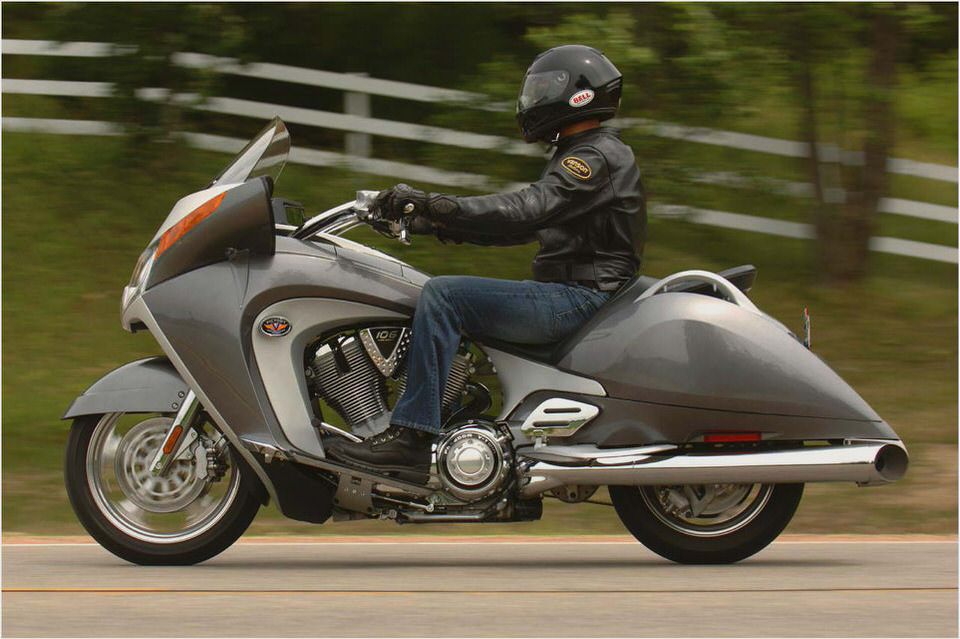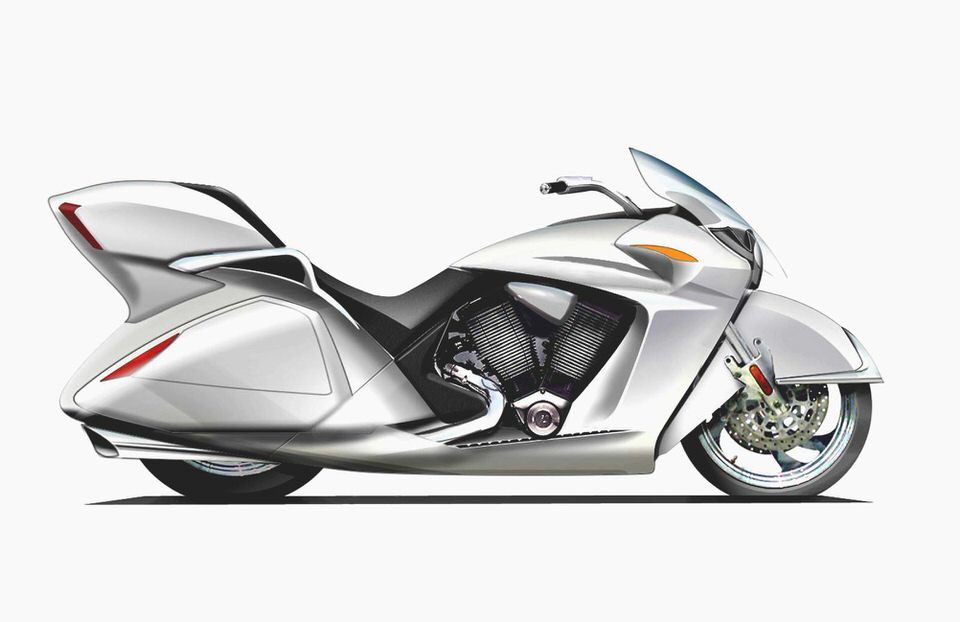Victory’s Bold Attempt to Reinvent the American Touring Motorcycle
It’s been a decade since Victory, the other American motorcycle manufacturer, unveiled their first bike. After their auspicious debut, the Minnesota-based bike builder got their act together and managed to overcome quality control problems, establishing themselves as a viable alternative to Harley-Davidson.
While partnering with Arlen and Cory Ness has heightened the company’s reputation for street savvy design, nothing could quite prepare the touring segment for Victory’s aggressively styled Vision. How does it stand up to the competition? Read on.
Looks That Kill: Sizing Up the Victory Vision’s Love it or Leave it Styling
Though the Vision began life as the Vision 800 concept. Victory officials claim the new bike was inspired by the voice of consumers. In fact, the direction of the final product was guided by numerous styling salons that were held throughout the US.
Victory brass also admit that the Vision has love it or leave it looks, and that its dramatic style isn’t for everybody. so which is it? Well, a little bit of both.
At once retro and futuristic, the Vision resembles the wild sketches of a daydreaming schoolboy. The fairing that houses the modern headlight is bulky, and when viewed head on. the width of the bodywork is downright imposing.
Get past the front end, and things start to get more streamlined. Aluminum trim surrounds the engine, a 106 cubic inch (1,731 cc) air and oil-cooled V-Twin that boasts old school American looks. Victory brass like to call the mill a jewel in the setting, and gemological references aside, it certainly does provide a strong focal point amidst the bike’s swoopy body panels.
The rear of the bike resolves the bulky front end nicely; curvaceous hard cases on either side are large enough to store an extra large helmet, and the tall trunk (which is large enough for two full face helmets. and also doubles as a passenger backrest and speaker enclosure) differentiates the Tour from the Street version. Incidentally, the trunk mounts to the bike’s subframe, and can be added to the Street version.
Rounding out the rear are slickly integrated exhaust pipes, and V shaped rear lights.
Beneath the Skin: What’s Hiding Under Those Sexy Curves?
Under the Vision’s skin.
© Victory
Though the Vision looks like an unwieldy beast, there are a few technological advances beneath its skin intended to keep weight relatively low– with a strong emphasis on the word relatively.
The Vision Street tips the scales with a dry weight of 804 lbs (add 45 lbs more for the Tour version), but Victory incorporates a few tricks to keep the Vision from completely porking out, including the use of front and rear hollow cast aluminum frame members. Though the bike appears low, considerable ground clearance prevents it from scraping during turns. Most of the suspension loads are carried by the frame, which also acts as an integrated airbox. Air is routed through the frame to the engine, which functions as a stressed member (eliminating the need for a downtube.)
Up front, on either sides of the steering head, are large twin aluminum fuel tanks which hold a total of six gallons. They’re positioned relatively high, so you are likely to notice a difference in balance at low speeds when loaded up with fuel.

Overall, the Vision’s engineering reveals Victory’s strong efforts to stay on top of the very competitive touring game.
Where the Rubber Meets the Road: Visionary Ride Handling
The Vision isn’t nearly as difficult to handle as it looks. A seat height of 26.5– the lowest in its class– and a low center of gravity make it surprisingly manageable at low speeds. In fact, at the international press launch of the bike one 5′ 6 tall journalist had no difficulty keeping the bike upright during parking lot maneuvers. There was a bit of tip-toeing involved during standstills, but for the most part, he handled the bike with ease.
If the bike is accidentally dumped, integrated tip over protection with front and rear structural supports prevent that pretty bodywork from being damaged.
Stability only grows with velocity, and the front end doesn’t start to loosen until you approach triple digit speeds. Throughout a variety of low and high speed turns, the Vision’s chassis feels solid and planted, without noticeable flex or uncertainty; while the front shocks are not adjustable, the rear air suspension can be stiffened or softened for varying passenger and cargo loads via a Schroeder valve and a standard air pump.
Ride comfort is good at all speeds, and 120 mm of rear suspension travel enable it to soak up all but the biggest bumps with ease. Because of the forward leg position, the supportive seat, and the bike’s easy to live with ergonomics, the Vision makes for a comfy companion on long trips.
The V-Twin’s Rumble is Nice.
With the optional premium package, this Victory logo becomes backlit.
© Basem Wasef, Licensed to About.com





- Big finishes: After Vegas victory, Brad Keselowski believes NASCAR’s…
- 2014 Victory Motorcycles Announced: 8-Ball Versions of Cross Roads and…
- 2011 Victory Hammer 8-Ball – Used 2011 Hammer 8Ball at Motorcyclist Magazine
- 2013 Zach Ness Cross Country Baggers
- 2010 Victory Motorcycles Line-up Preview –
